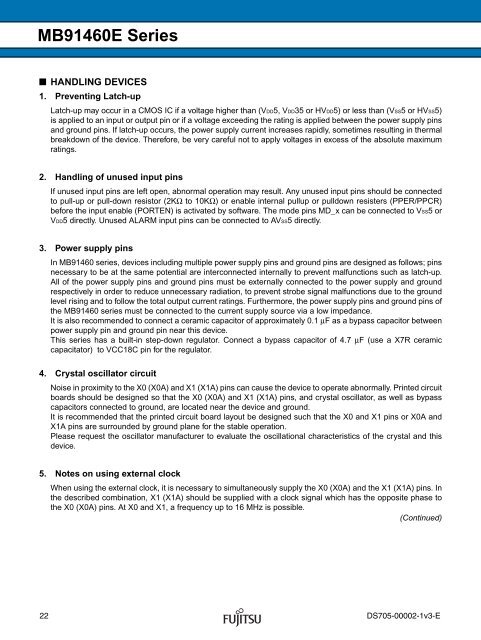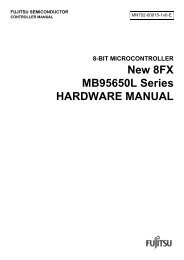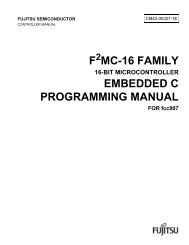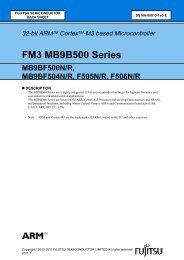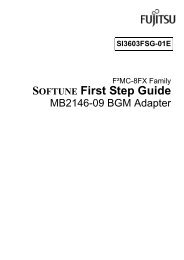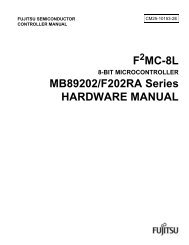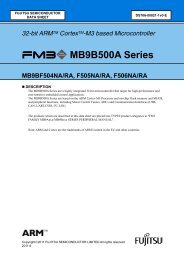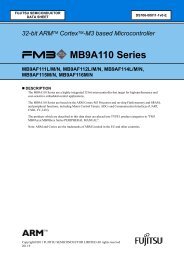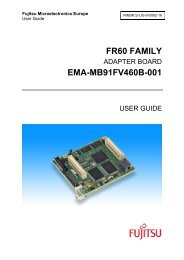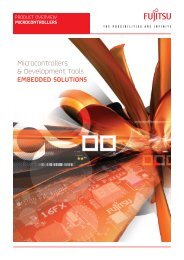FR60 MB91460E Series - Microcontrollers - Fujitsu
FR60 MB91460E Series - Microcontrollers - Fujitsu
FR60 MB91460E Series - Microcontrollers - Fujitsu
Create successful ePaper yourself
Turn your PDF publications into a flip-book with our unique Google optimized e-Paper software.
<strong>MB91460E</strong> <strong>Series</strong><br />
■ HANDLING DEVICES<br />
1. Preventing Latch-up<br />
Latch-up may occur in a CMOS IC if a voltage higher than (VDD5, VDD35 or HVDD5) or less than (VSS5 orHVSS5)<br />
is applied to an input or output pin or if a voltage exceeding the rating is applied between the power supply pins<br />
and ground pins. If latch-up occurs, the power supply current increases rapidly, sometimes resulting in thermal<br />
breakdown of the device. Therefore, be very careful not to apply voltages in excess of the absolute maximum<br />
ratings.<br />
2. Handling of unused input pins<br />
If unused input pins are left open, abnormal operation may result. Any unused input pins should be connected<br />
to pull-up or pull-down resistor (2KΩ to 10KΩ) or enable internal pullup or pulldown resisters (PPER/PPCR)<br />
before the input enable (PORTEN) is activated by software. The mode pins MD_x can be connected to VSS5 or<br />
VDD5 directly. Unused ALARM input pins can be connected to AVSS5 directly.<br />
3. Power supply pins<br />
In MB91460 series, devices including multiple power supply pins and ground pins are designed as follows; pins<br />
necessary to be at the same potential are interconnected internally to prevent malfunctions such as latch-up.<br />
All of the power supply pins and ground pins must be externally connected to the power supply and ground<br />
respectively in order to reduce unnecessary radiation, to prevent strobe signal malfunctions due to the ground<br />
level rising and to follow the total output current ratings. Furthermore, the power supply pins and ground pins of<br />
the MB91460 series must be connected to the current supply source via a low impedance.<br />
It is also recommended to connect a ceramic capacitor of approximately 0.1 µF as a bypass capacitor between<br />
power supply pin and ground pin near this device.<br />
This series has a built-in step-down regulator. Connect a bypass capacitor of 4.7 µF (use a X7R ceramic<br />
capacitator) to VCC18C pin for the regulator.<br />
4. Crystal oscillator circuit<br />
Noise in proximity to the X0 (X0A) and X1 (X1A) pins can cause the device to operate abnormally. Printed circuit<br />
boards should be designed so that the X0 (X0A) and X1 (X1A) pins, and crystal oscillator, as well as bypass<br />
capacitors connected to ground, are located near the device and ground.<br />
It is recommended that the printed circuit board layout be designed such that the X0 and X1 pins or X0A and<br />
X1A pins are surrounded by ground plane for the stable operation.<br />
Please request the oscillator manufacturer to evaluate the oscillational characteristics of the crystal and this<br />
device.<br />
5. Notes on using external clock<br />
When using the external clock, it is necessary to simultaneously supply the X0 (X0A) and the X1 (X1A) pins. In<br />
the described combination, X1 (X1A) should be supplied with a clock signal which has the opposite phase to<br />
the X0 (X0A) pins. At X0 and X1, a frequency up to 16 MHz is possible.<br />
(Continued)<br />
22 DS705-00002-1v3-E


